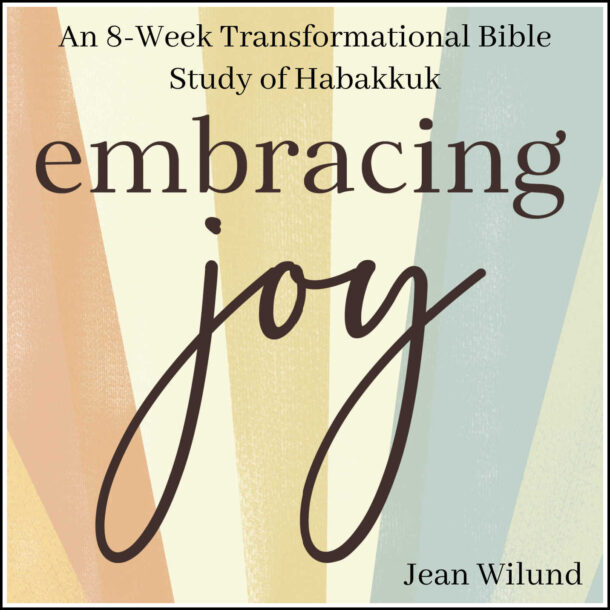(Scroll to bottom for three Bible Study Plans)
Transcript:
Ease into the Bible is not a Bible study, but are you wondering if you can use it as a Bible study? The answer is yes! In today’s episode, I’ll share with you how you can do this.
I’m Jean Wilund, but it’s ALL about Him! Welcome to a fun place to get serious about Bible Study.
The other day, I was talking with a friend about this very topic.
She was wondering how she could take Ease into the Bible and make it into a Bible study to use with a group at her church. OR ALSO to use it one-on-one with a friend.
In a minute, I’m going to share with you some suggestions for how I’ve grouped the 15 chapters in Ease into the Bibleinto 4-week, 6-week, and 8-week Bible study plans.
If your group wants to meet for a different length of time, you can easily adapt any of these plans to fit your group.
Free Discussion Guide
The first thing, though, I want you to do after you’ve listened to this episode is to download the free Discussion Guide for Ease into the Bible. You’ll find this guide on my website (JeanWilund.com) and on EaseIntoTheBible.com.
This guide is perfect to use with a group or one-on-one with a friend. The Discussion Questions cover each chapter of the book.
And as I said, there are 15 chapters.
In order to create studies of only 4, 6, or 8 weeks—instead of 15 weeks (which you can certainly do if you want)—I’ve grouped chapters together. I’ll explain as we go through why I chose the chapters I did to group together.
By the way, I’ll put these three plans in the podcast Show Notes. Plus, I’ll also include them with the transcript on my website so you don’t have to take notes. You’re welcome.
Podcast Episodes
As an added resource for any length Bible study on Ease into the Bible, you can play the podcast episodes for each chapter at the beginning of your meeting, or encourage your group to listen to the episodes at home.
As of right now (today as I’m recording this episode) I’m about to begin recording the episodes that discuss each chapter. It’s not a rehash of the chapters. I’m not going to do that. I’m going to give more information about what each chapter covers. I’m still working it all out in my mind. But I’ll get them up as quickly as possible so that I can hopefully keep ahead of you and your Bible study group’s needs.
Also, if you haven’t listened yet to Episode #4, Enjoy a Taste of Each Chapter in Ease into the Bible, I encourage you to listen to that episode, I share an overview of each chapter in the book, although I guess I kind of do that in this episode, too. I just do it a little differently.
Now, onto the different study plans.
Bible Study Plans Explained
Week One
For a Four-Week Study, I suggest covering the first three chapters in the first week.
Chapter 1
Chapter 1 of Ease into the Bible starts with an overview explanation of why the Bible is literally the greatest book ever written.
Chapter 2
Then, in Chapter 2, we discuss the Bible’s overarching story—the main point of the Bible.
Understanding its main point—its overarching story that’s woven from Genesis to Revelation—makes it easier for us to understand the Bible’s individual messages and how they connect to each other.
If we only get one thing from the Bible, we need to understand the main point.
Chapter 3
Chapter 3—Understanding the Uniqueness of Jesus—grounds us in why and how Jesus is unique among all others who have ever walked the earth.
Chapters 1 through 3 lay the foundation for understanding the Bible.
If you’re studying Ease into the Bible for any length that’s less than 14 or 15 weeks, I recommend grouping these three chapters together. This may seem like a lot to cover in one week, but it’s really not. The reading is very easy.
Week Two
The next grouping I recommend for a 4, 6, or 8-week Bible study are Chapters 4, 5, and 6.
Chapter 4
Chapter 4 addresses a common question of how we can know we can trust the Bible.
This can be a nagging question even among the sincerest Believers. We know it’s God’s Word—and yet, humans penned it. Common ordinary men put the words onto the scrolls! Can we really trust it?
Combining that chapter (Chapter 4) with Chapter 5—Who Wrote the Bible—just makes sense.
Chapter 5
Chapter 5 gives an overview of those human authors and helps ground us in why we can trust their words.
Chapter 6
Another common concern—and thus why I group Chapter 6 with the Chapters 4 and 5—is how we got the 66 books of the Bible. Did a group of men vote on the ones they liked best? How were they chosen? Or were they chosen?
To have confidence in what we’re reading, we want to answer this question.
By studying Chapters 4 through 6 together in Week Two, we build upon the foundation we laid in the first week—the divine content of the Bible from its ultimate Author—God.
Week Three
Starting in Week 3, we begin to look at how the Bible is organized.
This is where I suggest the four, six, and eight-week studies veer off from each other.
For the 4-week studies, I suggest covering Chapters 7 through 10.
For the 6-week studies, I suggest covering Chapters 7 through 9.
And for the 8-week studies, chapters 7 and 8.
Let’s look at these four chapters and why they’re grouped together over one or two weeks.
Chapter 7
Chapter 7 looks at how the Bible is organized. (Spoiler alert—it’s organized by its main genre. I wonder if I should have made you read the book to find that out. Oh well, too late.)
Chapter 8
Chapter 8 discusses how most of us thought the Bible is organized…chronologically. If you’ve read the whole Bible and didn’t know when you started that it’s not organized chronologically, you probably were as surprised as I the first time I read it straight through when it suddenly stopped being chronological.
If you’re doing a longer study, you can dive deeper into the various genre of the Bible that we cover in Chapter 7. We only touch on them in Chapter 7.
If you’re doing a shorter study, you can discuss them, but merely touch on them like we do in the chapter to ground yourself in a basic understanding.
Chapter 9
Chapter 9 talks about Bible reading plans—some of the best and worst Bible reading plans.
Chapter 10
Chapter 10 discusses Bible translations, which you use as you read and study the Bible. We also look at how to know which Bible translation is best for you.
If you’ve never studied the translating process, you’ll be surprised to discover the different methods and different goals for each method. You’ll also be surprised by how wonderfully helpful it is to know this information, and how it simplifies choosing the next Bible you want to buy.
Week Four
Now we’re at Week 4, and if you’re paying attention, you realize there’s still 5 chapters to cover.
If you only have 4 weeks for your study, you’re only going to dip your toes into the topics of the last five chapters.
But you’ll find this dip very helpful. And if your group is willing to dig into these chapters more on their own later, the resulting fruit will be tremendous.
As I mentioned before, you’ll see, if you haven’t already started reading Ease into the Bible, that this book truly is an easy read. It’s not one that forces you to stop and re-read paragraphs to be able to digest the material. That’s not to say the book is full of fluff—it’s not—but rather that this book is designed to prime the pump of your ponderings, not go into a deep dive.
Thus, your 4-Week Bible study group can cover the last five chapters in only one week, especially when I tell you that I don’t expect you to discuss the final chapter—Chapter 15.
Chapter 15 (Yes, this chapter is out of order.)
Chapter 15 dips our toes into every book of the Bible with a short Christ-centered summary. You may want to ask a few of the discussion questions in your time together, but I don’t expect you to dive into much of this chapter at all in either the four- or the six-week Bible study groups.
If you’re leading a six-week study, in Week 4, you’ll cover Chapter 10 (about Bible translations) and Chapter 11 (about studying the Bible).
The eight-week study groups will cover Chapters 9 (Bible Reading Plans) and 10 (Bible Translations) in Week 4.
Chapter 11 (See other episodes for more information on this important chapter)
You’ll discuss Chapter 11 (studying the Bible) in the 5th week.
Week Five
By the fifth week, the Four-Week study groups are done.
The Six-Week Groups will cover—in Week 5—Chapters 12 and 13.
I’ve also grouped these two chapters together for the Eight-Week study groups.
Let’s look at why I grouped them together.
Chapter 12
Chapter 12 discusses what many may be unfamiliar with and likely misunderstand—Doctrine: what is it and why does it matters?
This exciting chapter opens up an area that is sadly too often neglected and tremendously helpful.
Chapter 13
Chapter 13 discusses another area that is becoming more and more neglected: Church. We look at the purpose of the church and why it matters.
This may seem to be a bit off-topic in a book about the easing into the Bible, but you’ll quickly see why this chapter is so important to your understanding of—and your love for—the Bible.
Week Six
In Week 6, the Six-Week study groups will cover the last two chapters— Chapters 14 and 15.
The Eight-Week study Groups get to study each of these chapters by themselves.
(Remember, the list of each reading plan is in the show notes and on my website if you’re feeling a bit lost on which week we’re talking about because I’m getting lost, I think.)
Now, let’s look at why I group Chapters 14 and 15 together for the six-week study groups— besides the simple reason that it’s their last week of their study.
The other reason is because I want you to have more time to spend going through the Bible Study Tools and Resources in Chapter 14. And since Chapter 15 can be studied at home, this gives you most of your lesson time to dive into Chapter 14—how to use the different Bible study tools—and just a little time to go through some of Chapter 15’s discussion questions.
I encourage you as a Bible study leader to bring a laptop with you when you go through Chapter 14 on Bible study tools and resources. You can encourage your whole group to bring their laptops. This will allow all of you to get onto the internet during your time together and pull up some of the tools I suggest that are available free online.
Since I’m a visual learner, seeing someone walk through how to use a biblical resource is easier for me to remember than simply reading it—or listening to it if you’re letting Kindle read Ease into the Bible to you. If you have some of the books I recommend, bring those with you as well. Go through all this together.
Weeks Seven and Eight
The 8-Week Study Groups will get a full week for each of the last two chapters.
Chapter 15
In your last week, Chapter 15, you’ll be able to dive into many of the Bible book summaries or use the time to celebrate and discuss the highlights of your previous weeks together.
Final Notes
I hope by now that all of you have seen that you can easily lead a Bible study group through Ease into the Bible or go through it with a friend, one-on-one.
Remember to download your copy of the free Discussion Guide and Bible study group plans on my website, JeanWilund.com. Or on EaseIntoTheBible.com
If you have any questions, reach out to me on my website. I have a contact page. Reach out to me through that contact page, and give me your suggestions for Bible study groups, or your questions. Maybe you have some more detailed questions that this episode has brought to your mind. Maybe something that I haven’t thought about that I can share in a later episode.
I want this whole season to benefit you as you as you go through Ease into the Bible, so please do not hesitate to reach out to me. I will respond to you as soon as possible.
Thanks for joining me today. If you like what you heard, share it with others. Hit the subscribe button and write a review on your favorite podcast app. I’m Jean Wilund. But It’s All About Him!
Bible Study Plans
Four-Week Study Plan:
1. Chapters 1– 3
2. Chapters 4–6
3. Chapters 7–10
4. Chapters 11–15
Six-Week Study Plan:
1. Chapters 1–3
2. Chapters 4–6
3. Chapters 7–9
4. Chapter 10–11
5. Chapter 12–13
6. Chapters 14–15
Eight-Week Study Plan:
1. Chapters 1–3
2. Chapters 4–6
3. Chapters 7–8
4. Chapters 9–10
5. Chapters 11
6. Chapters 12–13
7. Chapters 14
8. Chapter 15






